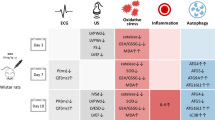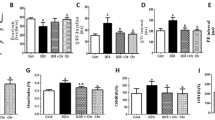Abstract
Doxorubicin (Dox) is a very potent anticancer agent, but its use is limited by its dose-dependent, irreversible cardiotoxicity. Despite intensive research efforts, the mechanism of Dox cardiotoxicity remains poorly understood, so very limited means are available for its prevention or effective management. Recent studies have revealed that a therapeutic dose of Dox can activate proteolysis in cardiomyocytes that is mediated by the ubiquitin-proteasome system (UPS), and that the UPS-mediated degradation of a number of pivotal cardiac transcription factors and/or survival factors is enhanced by Dox treatment. These findings suggest that Dox-induced UPS activation may represent a new mechanism underlying Dox cardiotoxicity. Notably, recent experimental studies suggest that proteasome activation promotes cardiac remodeling during hypertension. This review surveys the current literature on the impact of Dox on the UPS and the potential mechanisms by which UPS activation may compromise the heart during Dox therapy.
Similar content being viewed by others
References and Recommended Reading
Wang X, Su H, Ranek MJ: Protein quality control and degradation in cardiomyocytes. J Mol Cell Cardiol 2008, 45:11–27.
Tu D, Li W, Ye Y, Brunger AT: Inaugural article: structure and function of the yeast U-box-containing ubiquitin ligase Ufd2p. Proc Natl Acad Sci U S A 2007, 104:15599–15606.
Wang X, Robbins J: Heart failure and protein quality control. Circ Res 2006, 99:1315–1328.
Davies KJ: Degradation of oxidized proteins by the 20S proteasome. Biochimie 2001, 83:301–310.
Powell SR: The ubiquitin-proteasome system in cardiac physiology and pathology. Am J Physiol Heart Circ Physiol 2006, 291:H1–H19.
Patterson C, Ike C, Willis PW 4th, et al.: The bitter end: the ubiquitin-proteasome system and cardiac dysfunction. Circulation 2007, 115:1456–1463.
Minotti G, Menna P, Salvatorelli E, et al.: Anthracyclines: molecular advances and pharmacologic developments in antitumor activity and cardiotoxicity. Pharmacol Rev 2004, 56:185–229.
Simunek T, Sterba M, Popelova O, et al.: Anthracycline-induced cardiotoxicity: overview of studies examining the roles of oxidative stress and free cellular iron. Pharmacol Rep 2009, 61:154–171.
Kumarapeli AR, Horak KM, Glasford JW, et al.: A novel transgenic mouse model reveals deregulation of the ubiquitin-proteasome system in the heart by doxorubicin. FASEB J 2005, 19:2051–2053.
Liu J, Zheng H, Tang M, et al.: A therapeutic dose of doxorubicin activates ubiquitin-proteasome system-mediated proteolysis by acting on both the ubiquitination apparatus and proteasome. Am J Physiol Heart Circ Physiol 2008, 295:H2541–H2550.
Kiyomiya K, Matsuo S, Kurebe M: Proteasome is a carrier to translocate doxorubicin from cytoplasm into nucleus. Life Sci 1998, 62:1853–1860.
Razeghi P, Baskin KK, Sharma S, et al.: Atrophy, hypertrophy, and hypoxemia induce transcriptional regulators of the ubiquitin proteasome system in the rat heart. Biochem Biophys Res Commun 2006, 342:361–364.
Razeghi P, Taegtmeyer H: Hypertrophy and atrophy of the heart: the other side of remodeling. Ann N Y Acad Sci 2006, 1080:110–119.
Qian SB, McDonough H, Boellmann F, et al.: CHIP-mediated stress recovery by sequential ubiquitination of substrates and Hsp70. Nature 2006, 440:551–555.
Gomes MD, Lecker SH, Jagoe RT, et al.: Atrogin-1, a muscle-specific F-box protein highly expressed during muscle atrophy. Proc Natl Acad Sci U S A 2001, 98:14440–14445.
Stitt TN, Drujan D, Clarke BA, et al.: The IGF-1/PI3K/Akt pathway prevents expression of muscle atrophy-induced ubiquitin ligases by inhibiting FOXO transcription factors. Mol Cell 2004, 14:395–403.
Yamamoto Y, Hoshino Y, Ito T, et al.: Atrogin-1 ubiquitin ligase is upregulated by doxorubicin via p38-MAP kinase in cardiac myocytes. Cardiovasc Res 2008, 79:89–96.
Fan GC, Zhou X, Wang X, et al.: Heat shock protein 20 interacting with phosphorylated Akt reduces doxorubicin-triggered oxidative stress and cardiotoxicity. Circ Res 2008, 103:1270–1279.
Chatterjee K, Zhang J, Tao R, et al.: Vincristine attenuates doxorubicin cardiotoxicity. Biochem Biophys Res Commun 2008, 373:555–560.
Liu J, Chen Q, Huang W, et al.: Impairment of the ubiquitin-proteasome system in desminopathy mouse hearts. FASEB J 2006, 20:362–364.
Tsimokha AS, Mittenberg AG, Kulichkova VA, et al.: Changes in composition and activities of 26S proteasomes under the action of doxorubicin-apoptosis inductor of erythroleukemic K562 cells. Cell Biol Int 2007, 31:338–348.
Kiyomiya K, Satoh J, Horie H, et al.: Correlation between nuclear action of anthracycline anticancer agents and their binding affinity to the proteasome. Int J Oncol 2002, 21:1081–1085.
Fekete MR, McBride WH, Pajonk F: Anthracyclines, proteasome activity and multi-drug-resistance. BMC Cancer 2005, 5:114.
Ito T, Fujio Y, Takahashi K, Azuma J: Degradation of NFAT5, a transcriptional regulator of osmotic stress-related genes, is a critical event for doxorubicin-induced cytotoxicity in cardiac myocytes. J Biol Chem 2007, 282:1152–1160.
Poizat C, Puri PL, Bai Y, Kedes L: Phosphorylation-dependent degradation of p300 by doxorubicin-activated p38 mitogen-activated protein kinase in cardiac cells. Mol Cell Biol 2005, 25:2673–2687.
Lim CC, Zuppinger C, Guo X, et al.: Anthracyclines induce calpain-dependent titin proteolysis and necrosis in cardiomyocytes. J Biol Chem 2004, 279:8290–8299.
Arola OJ, Saraste A, Pulkki K, et al.: Acute doxorubicin cardiotoxicity involves cardiomyocyte apoptosis. Cancer Res 2000, 60:1789–1792.
Haq S, Michael A, Andreucci M, et al.: Stabilization of beta-catenin by a Wnt-independent mechanism regulates cardiomyocyte growth. Proc Natl Acad Sci U S A 2003, 100:4610–4615.
Kalivendi SV, Konorev EA, Cunningham S, et al.: Doxorubicin activates nuclear factor of activated T-lymphocytes and Fas ligand transcription: role of mitochondrial reactive oxygen species and calcium. Biochem J 2005, 389:527–539.
Ho SN: The role of NFAT5/TonEBP in establishing an optimal intracellular environment. Arch Biochem Biophys 2003, 413:151–157.
Ito T, Fujio Y, Schaffer SW, Azuma J: Involvement of transcriptional factor TonEBP in the regulation of the taurine transporter in the cardiomyocyte. Adv Exp Med Biol 2009, 643:523–532.
Poizat C, Sartorelli V, Chung G, et al.: Proteasome-mediated degradation of the coactivator p300 impairs cardiac transcription. Mol Cell Biol 2000, 20:8643–8654.
Bodine SC, Latres E, Baumhueter S, et al.: Identification of ubiquitin ligases required for skeletal muscle atrophy. Science 2001, 294:1704–1708.
Murton AJ, Constantin D, Greenhaff PL: The involvement of the ubiquitin proteasome system in human skeletal muscle remodelling and atrophy. Biochim Biophys Acta 2008, 1782:730–743.
Li HH, Kedar V, Zhang C, et al.: Atrogin-1/muscle atrophy F-box inhibits calcineurin-dependent cardiac hypertrophy by participating in an SCF ubiquitin ligase complex. J Clin Invest 2004, 114:1058–1071.
Lagirand-Cantaloube J, Offner N, Csibi A, et al.: The initiation factor eIF3-f is a major target for atrogin1/MAFbx function in skeletal muscle atrophy. EMBO J 2008, 27:1266–1276.
Rajan V, Mitch WE: Ubiquitin, proteasomes and proteolytic mechanisms activated by kidney disease. Biochim Biophys Acta 2008, 1782:795–799.
Fukuda N, Sasaki D, Ishiwata S, Kurihara S: Length dependence of tension generation in rat skinned cardiac muscle: role of titin in the Frank-Starling mechanism of the heart. Circulation 2001, 104:1639–1645.
Solomon V, Goldberg AL: Importance of the ATP-ubiquitin-proteasome pathway in the degradation of soluble and myofibrillar proteins in rabbit muscle extracts. J Biol Chem 1996, 271:26690–26697.
Shringarpure R, Grune T, Davies KJ: Protein oxidation and 20S proteasome-dependent proteolysis in mammalian cells. Cell Mol Life Sci 2001, 58:1442–1450.
An J, Li P, Li J, et al.: ARC is a critical cardiomyocyte survival switch in doxorubicin cardiotoxicity. J Mol Med 2009, 87:401–410.
Li YZ, Lu DY, Tan WQ, et al.: p53 initiates apoptosis by transcriptionally targeting the antiapoptotic protein ARC. Mol Cell Biol 2008, 28:564–574.
Haupt Y, Maya R, Kazaz A, Oren M: MDM2 promotes the rapid degradation of p53. Nature 1997, 387:296–299.
Nam YJ, Mani K, Wu L, et al.: The apoptosis inhibitor ARC undergoes ubiquitin-proteasomal-mediated degradation in response to death stimuli: identification of a degradation-resistant mutant. J Biol Chem 2007, 282:5522–5528.
Wang S, Kotamraju S, Konorev E, et al.: Activation of nuclear factor-kappaB during doxorubicin-induced apoptosis in endothelial cells and myocytes is pro-apoptotic: the role of hydrogen peroxide. Biochem J 2002, 367:729–740.
Li Q, Sanlioglu S, Li S, et al.: GPx-1 gene delivery modulates NFkappaB activation following diverse environmental injuries through a specific subunit of the IKK complex. Antioxid Redox Signal 2001, 3:415–432.
Xie P, Guo S, Fan Y, et al.: Atrogin-1/MAFbx enhances simulated ischemia/reperfusion-induced apoptosis in cardiomyocytes through degradation of MAPK phosphatase-1 and sustained JNK activation. J Biol Chem 2009, 284:5488–5496.
LoConte NK, Thomas JP, Alberti D, et al.: A phase I pharmacodynamic trial of bortezomib in combination with doxorubicin in patients with advanced cancer. Cancer Chemother Pharmacol 2008, 63:109–115.
Author information
Authors and Affiliations
Corresponding author
Rights and permissions
About this article
Cite this article
Ranek, M.J., Wang, X. Activation of the ubiquitin-proteasome system in doxorubicin cardiomyopathy. Current Science Inc 11, 389–395 (2009). https://doi.org/10.1007/s11906-009-0068-8
Published:
Issue Date:
DOI: https://doi.org/10.1007/s11906-009-0068-8




